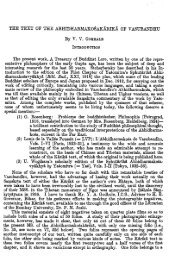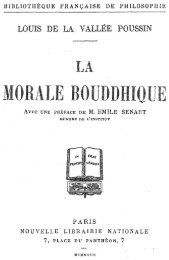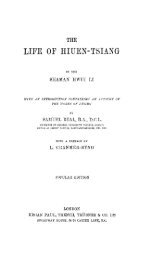La Vallée Poussin Musīla and Nārada. The Path - Gampo Abbey
La Vallée Poussin Musīla and Nārada. The Path - Gampo Abbey
La Vallée Poussin Musīla and Nārada. The Path - Gampo Abbey
You also want an ePaper? Increase the reach of your titles
YUMPU automatically turns print PDFs into web optimized ePapers that Google loves.
Musıla <strong>and</strong> N›rada. <strong>The</strong> <strong>Path</strong> of Nirv›˚a: by Louis de <strong>La</strong> <strong>Vallée</strong> <strong>Poussin</strong><br />
28<br />
conceptions”. <strong>The</strong>y stop reflecting <strong>and</strong> forming conceptions, <strong>and</strong>, therefore, the<br />
conceptions come to an end (nirudhyante). <strong>The</strong>y attain cessation (nirodha). 52<br />
b. KoŸa, ii, 43; iv, 56; vi, 43.<br />
ii, p. 203: “<strong>The</strong> noble persons (›rya) enter into this equipoise having attention (manasik›ra)<br />
directed toward the conception of a peaceful abode (Ÿ›ntavih›ra) as its antecedent”: that is to<br />
say, with a view to enjoying the peaceful (Ÿanta) abode (vih›ra), (i.e., ‘excellent concentration’<br />
[sam›dhiviŸe˝a]).<br />
iv. p. 123: <strong>The</strong> actions committed with regard to certain individuals are necessarily<br />
retributed in this lifetime, because of the eminent dignity of these individuals: “<strong>The</strong> persons<br />
emerge (vyutthita) from ‘equipoise of cessation’. In this equipoise, they have obtained an<br />
extreme tranquility (Ÿ›nti) of mind, for this equipoise is similar to nirv›˚a. When they<br />
emerge from this equipoise, it is as if one had gone to nirv›˚a <strong>and</strong> has returned from it”.<br />
(See Vibh›˝›, 154, p. 782, col.; Sa˙ghabhadra, 40, p. 572, col. 3 at end.)<br />
vi. p. 224 (Sa˙ghabhadra, p. 699, col. 2). – Those who are in possession of the ‘equipoise of<br />
cessation’ are called ‘those who have acquired cessation (nirodha)’. As it is ‘made present or<br />
actualized’ (s›k˝›tkaroti) through their body in view of the absence of mind, a factor (dharma)<br />
similar to nirv›˚a, namely, the ‘equipoise of cessation’, they are called ‘bodily witness’<br />
(k›yas›k˝in): in the absence of mind, this ‘making present or actualizing’ (s›k˝›tkriy› =<br />
pratyak˝ıkriy›) takes place depending on the body. – Such is the theory of the Vaibh›˝ikas.<br />
c. Sa˙ghabhadra, in contrast to the Sautr›ntika, establishes the reality of nirv›na which is not<br />
simply a cessation: ‘no longer existing after having existed’. In the commentary on the KoŸa,<br />
ii, 55 c-d, Taisho, 39, p. 432, col. 2, l. 5-14:<br />
<strong>The</strong> Sautr›ntika says that nirv›˚a has no intrinsic nature (Ch.: t’i; svabh›va, a way of being)<br />
that one can perceive the way one perceives color, sensation, that there is no activity<br />
(Ch.: yong; k›ritra) that one can perceive the way one perceives the activity of the visual or<br />
auditory sense-faculty. That is true: nirv›˚a is not perceived in its intrinsic nature or in its<br />
activity, the way it is the case for color <strong>and</strong> sensation, for the visual or auditory sense-<br />
faculty. But it does possess intrinsic nature <strong>and</strong> activity, of another order, capable of being<br />
known. Things produced by causes (sa˙ks¸ta) exist as a stream; their intrinsic nature <strong>and</strong><br />
their activity are coarse <strong>and</strong> easily discerned. Nirv›˚a, on the contrary, does not exist as a<br />
stream; its intrinsic nature <strong>and</strong> activity are subtle, hidden, difficult to discern. Nevertheless,<br />
the energetic <strong>and</strong> contemplative practitioners, when the discrimination (prajñ›) arisen from<br />
meditating (bh›van›m›yı) manifests in them, make present (s›k˝›tkaroti, ‘actualize’) the true<br />
intrinsic nature <strong>and</strong> activity of nirv›˚a. Emerging from contemplation, they cry out: “Oh!<br />
52 O. Franke, Dıghanik›ya… in Auswahl übersetzt, 1913, 149, 150; Rhys Davids, Dialogues, I, 250;<br />
Sumaºgalavil›sinı (Ed. Indian Hist. Quart., 18-19): saññ›vedayitanirodha˙ phusati vindati pa˛ilabhati.






